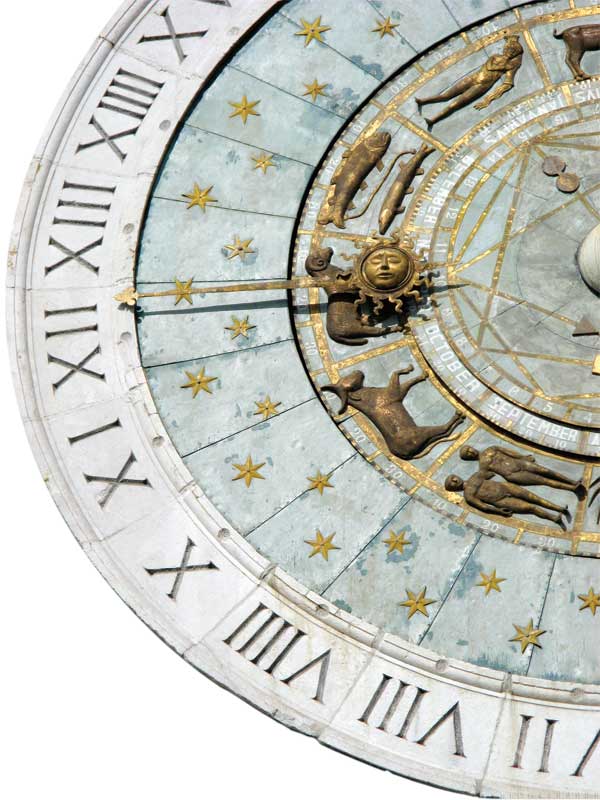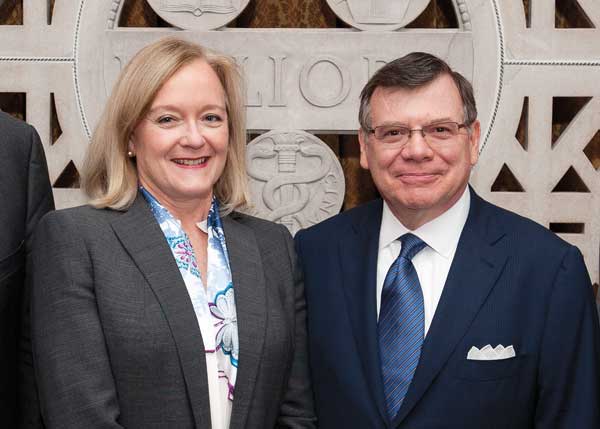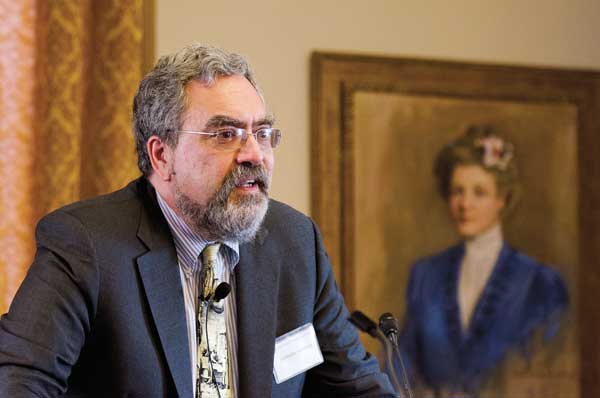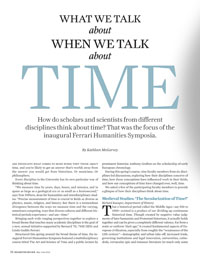Features
 STOP TIME: How the arts, sciences, and engineering think about time was the focus of the first Ferrari Humanities Symposia,
an annual initiative to explore multidisciplinary issues in the humanities. (Photo: iStockphoto)
STOP TIME: How the arts, sciences, and engineering think about time was the focus of the first Ferrari Humanities Symposia,
an annual initiative to explore multidisciplinary issues in the humanities. (Photo: iStockphoto)Ask physicists what comes to mind when they think about time, and you’re likely to get an answer that’s worlds away from the answer you would get from historians. Or musicians. Or philosophers.
Every discipline in the University has its own particular way of thinking about time.
‘Bringing Knowledge Together’
 NAMESAKES: A multidisciplinary outlook is key to understanding issues facing society, says Bernard Ferrari who, along with
his wife, Linda, provided support to establish the symposia series. (Photo: Adam Fenster)
NAMESAKES: A multidisciplinary outlook is key to understanding issues facing society, says Bernard Ferrari who, along with
his wife, Linda, provided support to establish the symposia series. (Photo: Adam Fenster)While an undergraduate studying science at Rochester, Bernard Ferrari ’70, ’74 (MD) took a course in medieval and Renaissance-era architecture and art. It kindled in him an enduring interest in the period and an appreciation for the arts and humanities.
Now Bernard Ferrari—a member of the Board of Trustees—and his wife, Linda Gaddis Ferrari, have established a humanities symposia and related curricula to explore collaborations between art and science. Thanks to their generous gift, which supports the $1.2 billion Meliora Challenge: The Campaign for the University of Rochester, students, faculty and the public will take part in the Ferrari Humanities Symposia yearly.
The symposia will feature a public talk from a visiting scholar with expertise in humanistic thought from the 14th to 17th centuries. The visiting scholar also will participate in courses designed to complement the lecture. This year’s visiting scholar, Anthony Grafton—the Henry Putnam University Professor of History at Princeton—shared his most recent research project, on the science of chronology in 16th- and 17th-century Europe.
A Rochester native, Bernard Ferrari earned a law degree and an MBA while working as the chief operating officer of the Ochsner Clinic in New Orleans. He went on to have a nearly 20-year career as director and partner in the global management consulting firm of McKinsey & Company. A former medical researcher and banker, Linda Gaddis Ferrari is now a docent at the Metropolitan Museum of Art.
“The study of the humanities provides people with the ability to better appreciate beauty, and better appreciate life,” says Bernard Ferrari, adding that the humanities are also relevant “to solving today’s problems when that knowledge is brought together with science and other disciplines.”
“Through the symposia, we hope to create another opportunity for students at the University to study, appreciate, and reflect on an extraordinary piece of history, while creating new collaborations for students in different academic disciplines,” he says.
—Valerie Alhart
A Tour of Time
 TIME SETTERS: Early European efforts to study chronology offer a model for interdisciplinary study today, says Grafton. (Photo: Adam Fenster)
TIME SETTERS: Early European efforts to study chronology offer a model for interdisciplinary study today, says Grafton. (Photo: Adam Fenster)When Anthony Grafton, the Henry Putnam University Professor of History at Princeton, took the lectern to deliver the inaugural keynote lecture of the Ferrari Humanities Symposia, he took the audience that crowded the Hawkins-Carlson Room at Rush Rhees Library on a dizzying tour of early modern Europe’s efforts at chronology. How did scholars reconstruct ancient calendars, and reconcile biblical accounts of the past with other depictions of bygone events?
“Chronology transformed the study of history,” Grafton told his listeners, calling the historical effort “more cosmopolitan than what would be taught until the 20th century.”
“I think this is a kind of model for how to think about interdisciplinary study now,” he said.
Grafton’s lecture, titled “Maps of Time: Science, Scholarship, and History in Early Modern Europe,” launched a course for undergraduates called The Art and Science of Time that was taught by nine faculty members from six departments, including art, physics, and English.
The author of 10 books and the coauthor, coeditor, or translator of nine others, Grafton has received a Guggenheim Fellowship, the Los Angeles Times Book Prize, the Balzan Prize for History of Humanities, and the Mellon Foundation’s Distinguished Achievement Award. He was president of the American Historical Association in 2011. His research focuses on the cultural history of Renaissance Europe, the history of books and readers, the history of scholarship and education in the West from antiquity to the 19th century, and the history of science from antiquity to the Renaissance.
—Kathleen McGarvey
“We measure time by years, days, hours, and minutes, and in spans as large as a geological era or as small as a femtosecond,” says Tom DiPiero, dean for humanities and interdisciplinary studies. “Precise measurement of time is crucial in fields as diverse as physics, music, religion, and history. But there is a tremendous divergence between the ways we measure time and the varying, sometimes competing, ways that diverse cultures and different historical periods experience—and use—time.”
Bringing such wide-ranging perspectives together to explore a broad theme that touches many academic disciplines is the goal of a new, annual initiative supported by Bernard ’70, ’74M (MD) and Linda Gaddis Ferrari. Structured this spring around the broad theme of time, the inaugural Ferrari Humanities Symposia featured a multidisciplinary course titled The Art and Science of Time and a public lecture by prominent historian Anthony Grafton on the scholarship of early European chronology. During this spring’s course,
nine faculty members from six disciplines led discussions, exploring how their disciplines conceive of time, how those conceptions have influenced work in their fields, and how our conceptions of time have changed over, well, time. We asked a few of the participating faculty members to provide a glimpse of how their disciplines think about time.
Medieval Studies: ‘The Secularization of Time?’
Richard Kaeuper, Department of History
That a historical period called the Middle Ages—say 500 to 1500—existed is a product of our dividing up continuous historical time. Though created by negative value judgments of later humanists and Protestant historians, it actually holds together and can be given a completely different valence. Far from a static or uniform “dark age,” it created fundamental aspects of European civilization, especially from roughly the “renaissance of the 12th century”—demographic and urban take-off, increased trade, governing institutions and legal innovation, universities, cathedrals, vernacular epic and romance literature (to touch only some aspects). If the later medieval centuries endured the Plague and destabilizing warfare, many of the achievements continued into more modern times.
A noted scholar, Jacques le Goff, argues that the great growth of Europe required the secularization of time in order to allow “usury”—the selling of time through interest on loans and mercantile endeavor in general, mistrusted formally by clerics. Early commercial capitalism, far from representing popular set will, generated fears and uncertainties within the population at large. In practice, elite clerics enthusiastically employed merchant-bankers.
The technological measurement of time in this era is equally interesting. Moving beyond ancient water clocks and sundials, medieval fabricators created a wealth of mechanical clocks, especially from the utilization of a suitable escapement mechanism by late decades of the 13th century. The age was technologically innovative. Richard of Wallingford is just one example of that inventive spirit: the orphaned son of a blacksmith and an Oxford-trained abbot, Wallingford in the 1330s wrote astronomical and mathematical treatises (one on spherical trigonometry) despite the lack of good numerical notation, thus requiring him to explain all ideas in Latin prose. He built a machina mundi, a mechanical cosmographical “clock” that not only rang hours, but also showed planetary motion.
Over the next century clocks appeared prominently around Europe and helped to regulate life, even as they demonstrated medieval inventiveness.
Religion: ‘In and Out of Time’
Emil Homerin, Department of Religion and Classics
Time may be a fundamental dimension of the universe or an innate structure of the mind. But, in terms of religion, time is relative to something much, much bigger: eternity.
Religions have often sought to understand the connection between this timeless infinity and our finite temporal lives. Worship, prayer, revelation, and enlightenment are religious activities and states of mind that often aim to transcend the duality of space and time in order to approach and, perhaps, merge with an eternal reality. Though eternity may be forever timeless, finite creation exists in time, though time’s direction may vary depending on religious traditions. Time may be linear or circular, progressive, static, or degenerative, and time’s direction may profoundly shape a believer’s view of the world. Many ancient and tribal religions have often viewed time as cyclical and bound up with the rhythms of the natural world, with the alternation of day and night, the changing seasons, and the phases of the moon. Other religions, especially the monotheistic traditions, generally conceive of time as linear, with a sequence of moments composing a meaningful history in which God is often depicted as acting purposefully.
Yet, no matter if a religion conceives of time as linear, circular, or both, the limited temporal world can still assist the believer in transcending time for eternity. With such a view, believers may spend their lifetimes living in a spiritually meaningful way. For all religions, one’s time in the world, then, has a direct effect on one’s contact with eternity, and various religious traditions have designed rites and rituals to assist their followers in leading a proper life marked by sacred times. These occasions are often part of annual communal rites and rituals that revolve around holy days and other sacred times that serve to spiritually renew or re-create the world. Further, mystical traditions in many religions urge us to step out of time in moments of selflessness, receptivity, and union not in order to see new worlds, but to see our old world anew.
Optics: ‘A Snapshot of Now’
Carlos Stroud, The Institute of Optics
We generally think of the present, or “now,” as a moving boundary between the past and the future. As a boundary it would seem not to have any duration of its own. However, the limitations of human perception only allow one to determine which of two events came first if they are separated by more than about 1/20th of a second. Thus, one might reasonably argue that “now” lasts about that long. Technological advances in the past 150 years have allowed us to artificially expand the boundaries of “now” from the age of the universe, 1017 seconds (about 14 billion years) to the duration of the shortest laser pulse produced to date, 10–17 seconds. Our perception of reality changes completely depending on the duration of our “now.”
The argument is illustrated by a simple experiment using a picture of highway traffic, shown with exposure times ranging from 4 seconds to 1/4000th second. On long exposures, the cars vanish; on short exposures, we see a grainy picture due to the arrival of individual quanta of light, photons. With an exposure time of a few centuries, the highway vanishes, and at an exposure of a few tens of thousands of years, the river alongside it vanishes. Eventually even the solar system will vanish from our imagined picture.
Such ideas prompt a series of questions: Has our increasingly precise ability to define “now” changed our fundamental perception of reality? Do individual humans vanish on the time scale of eternity? Could intelligent creatures exist on time scales much different from ours? What are the time scales of nations and those of individual people generally? The speed with which information is communicated has increased from walking speed to the speed of light. How does this affect the relation between time and distance?
Media Studies: ‘Televisual Time’
Joel Burges, Department of English, Film and Media Studies
As a critic whose work is obsessed with temporality in the present, I am interested in exploring the narrative structures that give rhythm and tempo to the experience of television.
For me, TV is all about time. I devote a big chunk of my free time to it. And I am only one among many. As writer Clay Shirky has pointed out, Americans spend billions of hours annually in front of the “boob tube.” This is a debt of time that in a decade rivals the national debt that politicians have bemoaned so much these past couple of years.
The series I most love often require a temporal commitment not only to a season, but also to a series. The TV industry also thinks about TV in terms of time. Almost every episode we watch is constructed around a series of “beats”—industry-speak for scenes—typically no longer that 2.5 minutes that give a rhythm to the 30- and 60-minute shows we watch in huge numbers every day. All of this is to say that TV is defined by a medium-specific temporal magnitude: the broadcast signal is—or was—ongoing across many channels 24 hours a day, 7 days a week, 365 days a year.
How does an episode of Community that can be watched independently of any other episode of the series organize televisual time for us? How does a nonlinear series such as Damages play with our temporal expectations about the way televisual narration should work? How are both Community and Damages shaped by commercial time—that is, by the fact that almost every episode of almost every series is structured around advertisements that occur at predetermined moments? Are there types of time on television that are neither commercial nor narrative? In investigating these questions, I hope to get students to reflect on the centrality of TV to not just millions and millions of spectators’ sense of time in the past 65 years, but also to their own temporal sense now.

